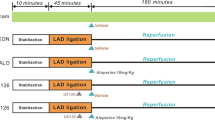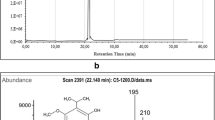Abstract
Salidroside (Sal), a phenylpropanoid glycoside isolated from a popular traditional Chinese medicinal plant Rhodiola rosea L., possesses multiple pharmacological actions. This aim of this study is to investigate the effects of Sal against isoproterenol (ISO)-induced myocardial ischemia. Fifty male Sprague–Dawley rats were randomized equally to five groups: control group, ISO group, Sal (20 mg/kg; 40 mg/kg) treatments groups, and propranolol (Pro, 15 mg/kg) group. Rats were treated for 14 days and then given ISO (80 mg/kg) for 2 consecutive days by subcutaneous injection. In vitro, we used H9C2 cells to investigate the effects of Sal against hypoxia–reoxygenation. ST-segment elevation was measured after the last administration. Serum levels of creatine kinase (CK), lactate dehydrogenase (LDH), tumor necrosis factor-α (TNF-α), interleukin-6 (IL-6), superoxide dismutase (SOD), and malondialdehyde (MDA); levels of NADPH oxidases 2 and 4 (Nox2 and Nox4), NF-κBP65, and AP1 in heart, and H9C2 cells were measured by Western blot. The hearts were excised for determining microscopic examination, SOD, and MDA measurements. Sal decreased the ST elevation induced by ISO, decreased serum levels of CK-MB, LDH, TNF-α, IL-6, SOD, and MDA. In addition, Sal increased SOD activity and decreased MDA content in myocardial tissue. Sal also decreased Nox2 and 4, NF-κBP65, P-NF-κBP65, and AP1 protein levels in the heart. The results support a further study of Sal as potential treatments for ischemic heart disease.








Similar content being viewed by others
References
Lopez, A.D., C.D. Mathers, M. Ezzati, D.T. Jamison, and C.J.L. Murray. 2006. Global burden of disease and risk factors. Washington (DC): World Bank.
Yang, G., Y. Wang, Y. Zeng, G.F. Gao, X. Liang, M. Zhou, X. Wan, S. Yu, Y. Jiang, M. Naqhavi, T. Vos, H. Wang, A.D. Lopez, and C.J. Murray. 2013. Rapid health transition in China, 1990–2010: findings from the Global Burden of Disease Study 2010. Lancet 381: 1987–2015.
Griendling, K.K., D. Sorescu, and M. Ushio-Fukai. 2000. NAD(P)H oxidase role in cardiovascular biology and disease. Circulation Research 86: 494–501.
Guha, M., W. Bai, J.L. Nadler, et al. 2000. Molecular mechanisms of tumor necrosis factor alpha gene expression in monocytic cells via hyperglycemia-induced oxidant stress-dependent and -independent pathways. Journal of Biological Chemistry 275: 17728e39.
Schreck, R., K. Albermann, and P.A. Baeuerle. 1992. Nuclear factor kappa B: an oxidative stress-responsive transcription factor of eukaryotic cells (a review). Free Radical Research Communications 17: 221e37.
Kucinskaite, A., V. Briedis, and A. Savickas. 2004. Experimental analysis of therapeutic properties of Rhodiola rosea L and its possible application in medicine. Medicina (Kaunas, Lithuania) 40: 614–619.
Willerson, J.T., and P.M. Ridker. 2004. Inflammation as a cardiovascular risk factor. Circulation 109: II2–10.
Zheng, W., L.Z. Huang, L. Zhao, B. Wang, H.B. Xu, G.Y. Wang, Z.L. Wang, and H. Zhou. 2008. Superoxide dismutase activity and malondialdehyde level in plasma and morphological evaluation of acute severe hemorrhagic shock in rats. American Journal of Emergency Medicine 26: 54–58.
Senthil, S., G. Chandramohan, and K.V. Pugalendi. 2007. Isomers (oleanolic and ursolic acids) differ in their protective effect against isoproterenol-induced myocardial ischemia in rats. International Journal of Cardiology 119: 131–133.
Acknowledgments
This work was supported by National twelve five major drug discovery project (2011ZX09102-002-01).
Author information
Authors and Affiliations
Corresponding author
Rights and permissions
About this article
Cite this article
Zhu, L., Wei, T., Chang, X. et al. Effects of Salidroside on Myocardial Injury In Vivo In Vitro via Regulation of Nox/NF-κB/AP1 Pathway. Inflammation 38, 1589–1598 (2015). https://doi.org/10.1007/s10753-015-0134-0
Published:
Issue Date:
DOI: https://doi.org/10.1007/s10753-015-0134-0




